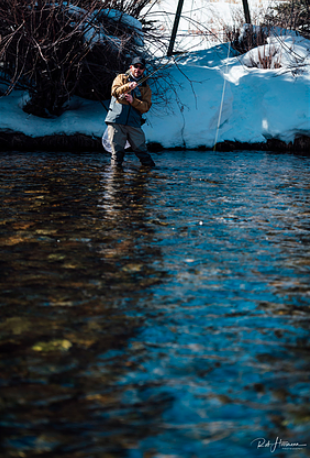
When it comes to having a successful day on the river, there are many factors to take into account. Fishing the appropriate patterns and targeting the right water is where many anglers focus their attention, but something that should never be overlooked is depth. At any given time, trout feed at varying depths of the river. The easiest observation to make is whether trout are feeding above or below the surface. This observation generally determines whether you fish a dry fly or nymph rig, but it is often more complicated than that.
Assuming you don’t see any surface activity, nymphing is a logical place to start, but acknowledging and adjusting the depth of your drift is critical. To help you better understand the considerations that should be made, we’ve broken it down into three key depths: surface, mid-column and deep-column.
Deep Column: Regardless of the time of year, trout do a majority of their feeding sub-surface. This is why nymphing is arguably the most consistent fishing method. When we make the decision to nymph, we’ve recognized that trout aren’t looking up at the surface. So, unless we see trout suspended in the middle column, our goal is to drift our flies through the deepest water column. To effectively do this, you need to use the appropriate amount of split shot (weight) and adjust your indicator according to the depth of the river. The general rule of thumb for indicator placement is 1.5X the depth of the river. For example, if you’re fishing a 4 ft. deep run, position your indicator 6 ft above your lead fly. This ensures that your flies are able to reach the bottom of the river.
Once your indicator is appropriately placed, you need to consider the amount of weight needed to get your flies down into the feeding zone. The biggest thing to consider is water velocity. If you’re fishing a slow pool, you may only need one, small split shot. But if you’re fishing a faster run or pocket water, adding one or two large split shots may be needed. While it may be annoying, getting snagged on the bottom of the river is a good sign that you’re using the appropriate amount of weight. Keep in mind, adjusting your weight may be necessary as you transition to new water.
Middle Column: When trout are suspended in the river or holding in the middle column, you have a couple options. Your first option is to decrease the weight on your nymph rig and/or slide your indicator closer to your lead fly. The idea behind sliding your indicator down is to limit the depth of your drift so that your flies drift through the top half of the river rather than the bottom. So how do you know whether to adjust your weight or your indicator? We base this decision on the type of water we are fishing. If it’s a slow pool, we prefer to decrease the weight as you’ll have more time for your flies to sink compared to fishing a faster run. When fishing faster water, we will keep our weight the same but slide the indicator down to control depth. This ensures that our flies reach the middle column quickly but don’t sink past that point.
Your second option is to fish a dry dropper. When trout feed in the middle column, they’re generally feeding on emerging bugs or looking up at the surface. Fishing a dry dropper allows you to cover both fronts. Start by selecting a buoyant dry fly that can support one or two nymphs and split shot if needed. Whether you’re dropping one or two nymphs, you’ll want to use 2 feet of tippet when you connect your nymph to your dry. This ensures that your nymph is able to get down into the middle column. If you’re struggling to get your nymphs down in faster water, add a small split shot 3 inches above your lead nymph.
Surface: When you see trout feeding on the surface, it’s a good indication that a dry fly setup is the way to go. Rig up your rod with a 9ft leader and attach 10 – 14 inches of tippet to the end (fluorocarbon is preferred). Having a long leader and extra tippet will limit surface disturbance when you cast. Since trout are looking up, they will be very sensitive to surface disturbance. An additional adjustment that can be made to your dry fly setup is trailing a spinner pattern or emerger behind your primary dry pattern. Leading up to and following a hatch, you may observe trout “sipping” below the surface rather than on the surface. To attract these trout, trail an emerger leading up to a hatch and a spinner dry fly pattern following a hatch.
